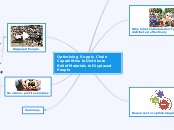Optimizing Supply Chain Capabilities to Distribute Relief Materials to Displaced People
Optimal Supply Chain

Associated with for-profit capability
Products available on demand
Supply synchronized with demand

Why relief materials don't get distributed effectively

No financial incetives
Not profitable for businesses
Consumers don't dictate quantity to be supplied
Volume available depends on funding, not consumption rate
Little / no supply chain capabilities

Resources for optimal supply chain

Transportation: Effective transportation system (drones, train, trucks, etc.)
Human: Professionals from public/private sector
NGOs: Not-for-profit concerns like Bill & Melinda Gates' Foundation
Donors: Resource availability on time by donors
Human Kindness: Genuine care & compassion for fellow humans in predicament
Government Policies: Mandating a certain percentage of common wealth to be channeled towards supporting displaced people
Collaboration: Public/Private partnership to ensure relief availability on time

Distribution Centers: Central locations where relief materials can be stored
Displaced People

Acts of War
Hositility
Religious ideology
Cultural intolerance
Genocide
Political attacks

Good non-profit examples
Bill & Melinda Gates' Vaccine distribution
Relief materials delivered with drones
